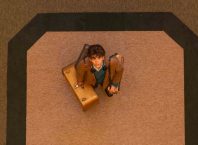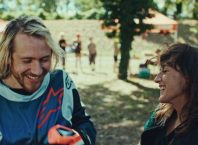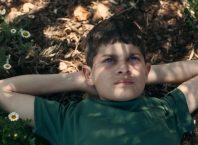The mid-career retrospective of Belgian artist Michaël Borremans (b.1963) comprises 100 paintings and drawings that captivate the eye with their beauty and the polished technical skill involved in their production. Initially trained in photography and the art of etching, he turned to drawing and painting in the mid-1999s. Today he is a preeminent contemporary artist with a unique voice.
This unique voice, characterized by a subversive attitude towards the established genres of painting like portraiture and still life, takes one by surprise, given the refined Flemish traditions which are his artistic heritage: illuminated miniatures and panel paintings that tell religious stories, still life studies of flowers and fruit heavy with symbolism, and dignified realistic portraits, exemplified by the work of Jan Van Eyck and the many artists that came after him.
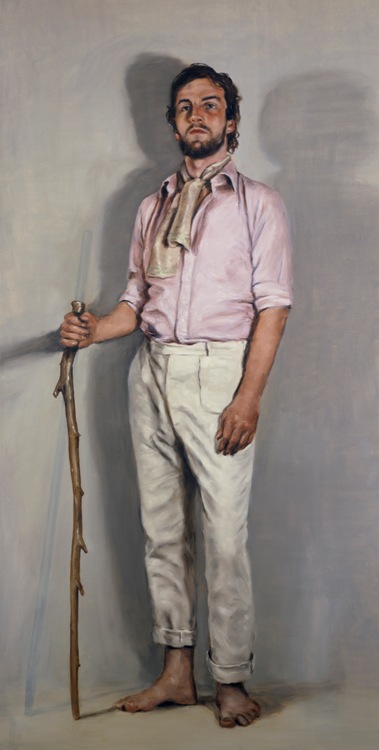
Oil on canvas, 360 x 180 cm
High Museum of Art, Atlanta
Courtesy Zeno X Gallery, Antwerp; David Zwirner, New York/London
© Ron Amstutz
Suited to this subversive approach is the exhibition’s cryptic title: As Sweet as it Gets. On one level it seems to express contentment. But it may also be interpreted as referring to troubling situations from which there can be no escape, or the possibility that the good life, like a bubble, could collapse at any time.
Among scores of small-format paintings, there are several monumental works. Among them The Avoider, a painting whose character reflects the basic concepts that underpin Borremans’ art including his propensity to quote from European masterworks. Two well-known images in art history are his starting point: a self-portrait of French realist artist Gustave Courbet from his painting Bonjour Monsieur Courbet (1854) showing him stopping to greet one of his patrons whilst on a country walk; and The Wanderer Above The Sea of Fog by German Romantic artist Caspar David Friedrich
However, studying Borreman’s version which, like most of his paintings is rendered in a palette of browns, beiges and grey with touches of brighter color, questions arise that are never answered. Who is this man? Why is he barefooted? What is he looking at? (As is customary in Borreman’s paintings, none of his ‘people’ look you in the eye.) No clues are given as regards location that would help in concocting a storyline, because actually there isn’t one. The lighting, shadows and neutral backcloth infer a studio portrait, But in conversation, the artist has insisted that he is not concerned with traditional portraiture. He describes the characters he depicts as stereotypes “like pieces in a chess game standing for something (else).” So who or what does this particular figure represent? Its anyone’s guess. Perhaps an introvert, a lover of solitude, hence the picture’s title.
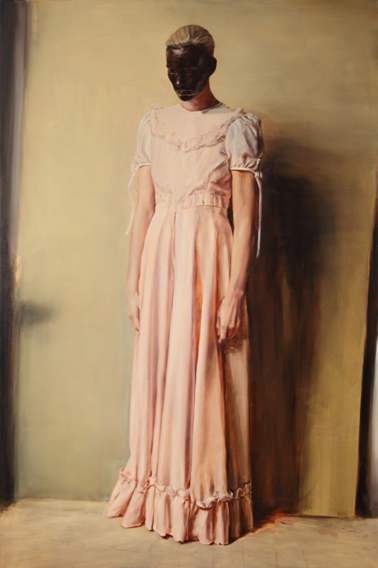
Oil on canvas, 300 x 200 cm
Courtesy Zeno X Gallery, Antwerp
© Dirk Pauwels
Angel, another commanding, larger- than- life work also defies explanation. It features an androgynous figure, devoid of wings, wearing a long pink party dress. Her/his face is painted black giving the impression of a mask. The downcast gaze and curiously passive stance of this figure bring to mind the figure of Synagoga (synagogue), blindfolded and bound, that is paired with Ecclesia (church) on the sculpted portals of Strasbourg Cathedral and other Christian places of worship. If Borremans identifies this figure as an angel, then we must be looking at the Angel of Death.
Violence or violent actions are the hallmark of a significant number of paintings by Borremans: The Whistler (2009) for example, a nude figure that has a sliver of wood forced into his mouth – perhaps because his playing failed to please his audience!; and Columbine (2008) depicting the mutilated face of a woman, her eye pierced by a shard of glass or some sharp instrument.
The surreal aspect of Borreman’s art is given full expression in his drawings where sculptural plinths and theatrical staging recall elements in the art of his compatriot René Magritte. In this medium (pencil and watercolors on paper) the artist has turned to exploring themes related to human behavior. Indifference to the suffering of others is the theme of The Swimming Pool ( 2001) where a youth with holes punctured into chest is being tortured. Below this scene, people are swimming in a pool, oblivious to what is happening.
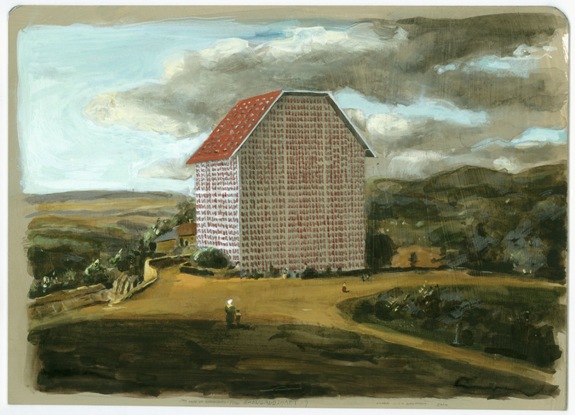
Pencil, watercolor and gouache on cardboard, 18.26 x 25.24 cm
S.M.A.K., Ghent
Courtesy Zeno X Gallery, Antwerp
The failure of architecture to design buildings that people really want is one theme explored in a set of drawings titled House of Opportunity. All of them depict in a variety of scales and dimensions, a barn like structure with mullioned windows but no doors. In the version illustrated above, people, the size of insects, stare up (in awe? In horror?) at the gigantic building dominating the parkland. In another scary version, a woman is shown tipping the barn on its side. If this building presents home, then, as families in Israel have recently found out, Borremans is intimating that this place cannot always be counted on to provide a safe haven.
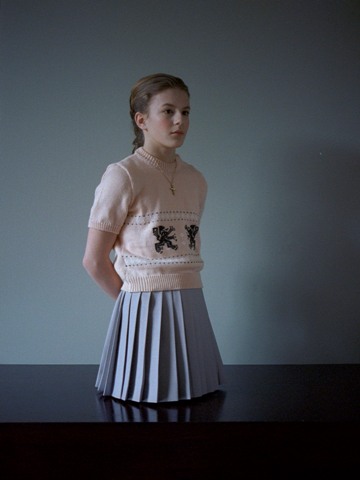
35-mm film, 9:44 min
Framed 15-inch screen, edition of 3
Courtesy Zeno X Gallery, Antwerp; David Zwirner New York/London; and
Gallery Koyanagi, Tokyo
Several films translated into DVDs are part of Bourremans’ intriguing attempts to introduce movement into a static image. In one instance, his camera pans very slowly over the painting of a young girl to give the impression that her head is turning ever so slightly and the pleats of her skirt are in motion. Tableaux vivants – living pictures – are the result. Like many of the works in this gripping show, these images appear to exist in a dream world fueled by reality.
This exhibition organized by BOZAR, Center for Fine Arts, Brussels, and the Dallas Museum of art in collaboration with the Tel Aviv Museum of Art, was guest curated by Jeffrey Grove . Curator in Charge at TAMA is Ahuva Israel. The show runs until January 31st 2015.



